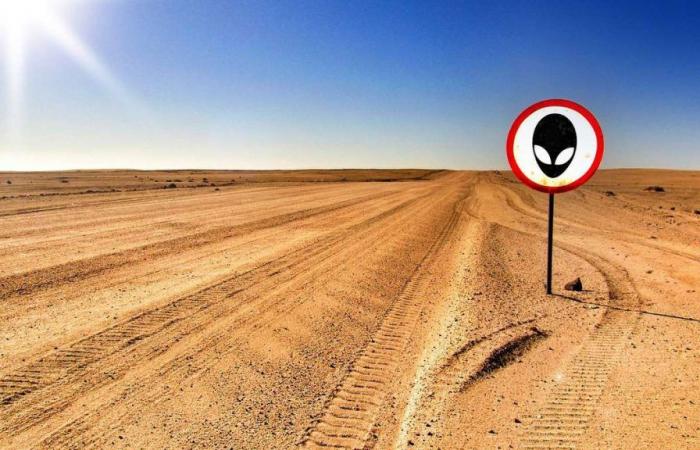For decades, Area 51 had been the focus of rumors and conspiracy theories linking it to the study of extraterrestrial ships and alien technology.
Photo: Pixabay – Schäferle
Human beings have always felt an intense curiosity to explore every corner of the planet. However, despite technological advances and the desire to conquer, there are still numerous places that remain closed to most people. These areas are kept inaccessible whether for reasons of security, environmental protection, legal restrictions or respect for cultural and religious beliefs.
Here we make a list of some of those places that are prohibited and that you can only see through photos.
Area 51, Nevada
This list is clearly topped by Area 51, a top-secret military installation located in a remote Nevada desert that has been the focus of intense speculation and conspiracy theories for decades. Initially linked to rumors about the study of extraterrestrial spacecraft thanks to statements by an alleged former employee in 1989 – which were quickly discredited – the truth is that the nature of the activities carried out there remain a secret.
In fact, it was not until 2013 that the US government admitted the existence of this complex of almost 150 hectares with restricted airspace, although it is known that since 1955 the CIA, the Atomic Energy Commission and other organizations have used it for nuclear tests, testing of drones and advanced spy ships, however, in general, the world still does not know the purpose of this base. Regarding tourism, while The perimeter can be visited on tourist excursions, access to the base is strictly prohibited.
The Doomsday Vault, Norway
The Svalbard Global Seed Vault, also known as the “End of the World Vault,” is a facility located on a remote Norwegian archipelago within the Arctic Circle. And although its name may be intimidating, its objective really is not, as it is built to serve as a global seed bank, storing crop samples from all over the planet to preserve agricultural biodiversity in the event of a possible global catastrophe. Inside the building, which is 130 meters deep inside a mountain and was designed to resist natural disasters and attacks, more than 1 million varieties of seeds from 249 countries are stored, wrapped in special packages to guarantee its conservation for hundreds or thousands of years.
Given its vital importance in safeguarding the future of food in the worldaccess to the Doomsday Vault is strictly restricted to authorized personnel and scientists only. No outside visitors are allowed, making this Norwegian facility one of the most protected and sealed places on the planet. Its remote location and sophisticated security systems make it the last bastion of global agricultural biodiversity in the event of any apocalyptic scenario that could threaten crops.
Queimada Grande Island, Brazil
It is located about 30 kilometers off the coast of São Paulo, Brazil, and is known as the “Snake Island” due to the extraordinary density of these animals. It is estimated that on this small island of 43 hectares there may be 1 snake of the species Bothrops insularis for every square meter. This incredible concentration is due to the fact that the island was isolated from the mainland 11,000 years ago, forcing the snakes to evolve and become up to five times more venomous than their continental counterparts in order to hunt migratory birds, as there were no mammals available.
Given the extreme danger that these snakes represent with their potentially lethal bite, Brazilian authorities have strictly prohibited anyone’s access to Queimada Grande Island. Only a few scientists and researchers have special permits to enter this remote location. Even poachers who manage to enter illegally to capture specimens and sell them on the black market expose themselves to mortal risk.
The Tomb of Qin Shi Huang, China
The tomb of the first emperor of unified China, Qin Shi Huang, located in Xi’an, remains one of the world’s greatest archaeological mysteries. Although his impressive army of terracotta warriors guarding the abode was accidentally discovered in 1974, the tomb itself remains sealed and unexplored, This is because archaeologists fear that any attempt to excavate and access the interior could irreparably damage the secrets it contains.
And not only do the risks of deterioration limit this exploration, but it is said that there are “traps” designed to protect it from intruders. These suspicions are based on the accounts of ancient historian Sima Qian, who described the existence of loaded crossbows, arrows and rivers of liquid mercury waiting for anyone curious. Regarding this last trap, research carried out in 2020 using soil scans found unusually high levels of mercury in the area, suggesting that even stepping foot in it would be a risk. Thus, 2,200 years after its construction, The mysterious mausoleum of Qin Shi Huang remains one of the most disturbing and jealously guarded burial chambers on the planet.
Surtsey Island, Iceland
Surtsey is a small volcanic island – barely 2.7 square kilometers in size – that emerged off the coast of southern Iceland between 1963 and 1967 following a series of eruptions. This new land formation has become a unique natural laboratory in the world, since since it emerged from the ocean, scientists have been able to monitor and catalog the arrival of the first forms of plant and animal life that have been colonizing this virgin territory. In addition, over the decades they have recorded the appearance of mosses, plants, lichens, fungi, invertebrates and even the arrival of various species of birds.
To preserve this valuable opportunity to study the establishment of an ecosystem from scratch, the island was declared a nature reserve in 1965 and the Surtsey Research Society was created for its management by the Reykjavík Natural History Museum. Access is completely restricted to avoid any type of contamination or introduction of external species that could alter the natural process.. In 2008 it was even declared a World Heritage Site by UNESCO.
North Sentinel Island, India
North Sentinel Island, located in the Andaman Islands archipelago in the Indian Ocean, It is home to one of the last tribes in the world that remain completely isolated and without contact with outside civilization.r. It is estimated that this small island – barely 59 square kilometers – lives between 50 and 400 members of the Sentinelese tribe, one of the few hunter-gatherer communities left on the planet. What is known about them is very little: that they are very hostile to any outsider who tries to approach them and that they would have migrated from Africa 60,000 years ago.
That is why the Indian authorities have declared illegal to visit the island to preserve the Sentinelese from contact with foreign diseases that could exterminate the entire tribe.
Gangkhar Puensum Mountain, Bhutan
At 7,570 meters above sea level, Gangkhar Puensum is the only major mountain peak on the planet that remains impregnable and has not been crowned by humans. Located in the Himalayan mountain range, on the border between Bhutan and China, this imposing mountain is considered sacred by local populations, who believe that spirits live on its slopes that should not be disturbed. For this reason, and out of respect for religious traditions, the government of Bhutan strictly prohibited any attempt to climb it in 2004.
Although this is also due to the bureaucratic challenges that the mountain presents, since being in a disputed border area between two nations, obtaining permits becomes even more complicated. In fact, Both Bhutan and China have imposed legal bans that prevent foreigners from even approaching to attempt the ascent of this virgin summit.keeping the mystery about when and who will finally manage to reach the top of this great mountain.
Mezhgorye, Russia
Located in the Ural Mountains, near Mount Yamantau, Mezhgorye is one of those closed cities that continue to operate in complete secrecy. It is believed to have been established between 1970 and 1980 for some classified military or industrial purpose and Access is only possible with special permissions from the intelligence services. In fact, it has strong security, as it has iron controls, surveillance posts, cameras and more, which prevent any unauthorized visitor from entering this town of 20,000 inhabitants, which also has airspace restrictions. The mystery extends kilometers underground in supposed underground facilities whose purpose is unknown.
Ise Shrine, Japan
Ise Shrine or Ise-jingū is the most important Shinto temple in Japan, located in the city of Ise, Mie Prefecture. It is made up of two main shrines: Naikū, dedicated to the goddess Amaterasu, and Gekū, dedicated to Toyouke no Ōmikami. These shrines, along with 123 other structures, are part of Ise-Shima National Park, considered one of the most sacred places in the country.
However, although it is an important place for Japanese culture, Access to the interior is reserved only for high-ranking Shinto priests and members of the Japanese imperial family. Although ordinary visitors can appreciate the exterior structures and enjoy the sacred surroundings.
Lascaux Cave, France
Lascaux Cave, located in southwestern France, is home to one of the most impressive examples of Upper Paleolithic rock art. Accidentally discovered in 1940 by some children, this cave contains nearly 600 paintings and 1,400 engravings of animals such as horses, deer, aurochs, goats, bison and felines, dated between 17,000 and 15,000 BC. The representations, made with natural pigments such as oxides of iron and manganese, stand out for their artistic skill and suggest a ritual or spiritual purpose.
However, due to the negative impact caused by the massive influx of visitors since its opening to the public in 1948, It was closed permanently in 1963 to preserve its priceless paintings from any further damage. Efforts have focused solely on controlling the spread of fungi and maintaining optimal environmental conditions within the original cave. To allow the appreciation of these works of rock artin 1983 Lascaux II was inaugurated, an accurate replica of the main decorated chambers, located 200 meters from the first cave.






